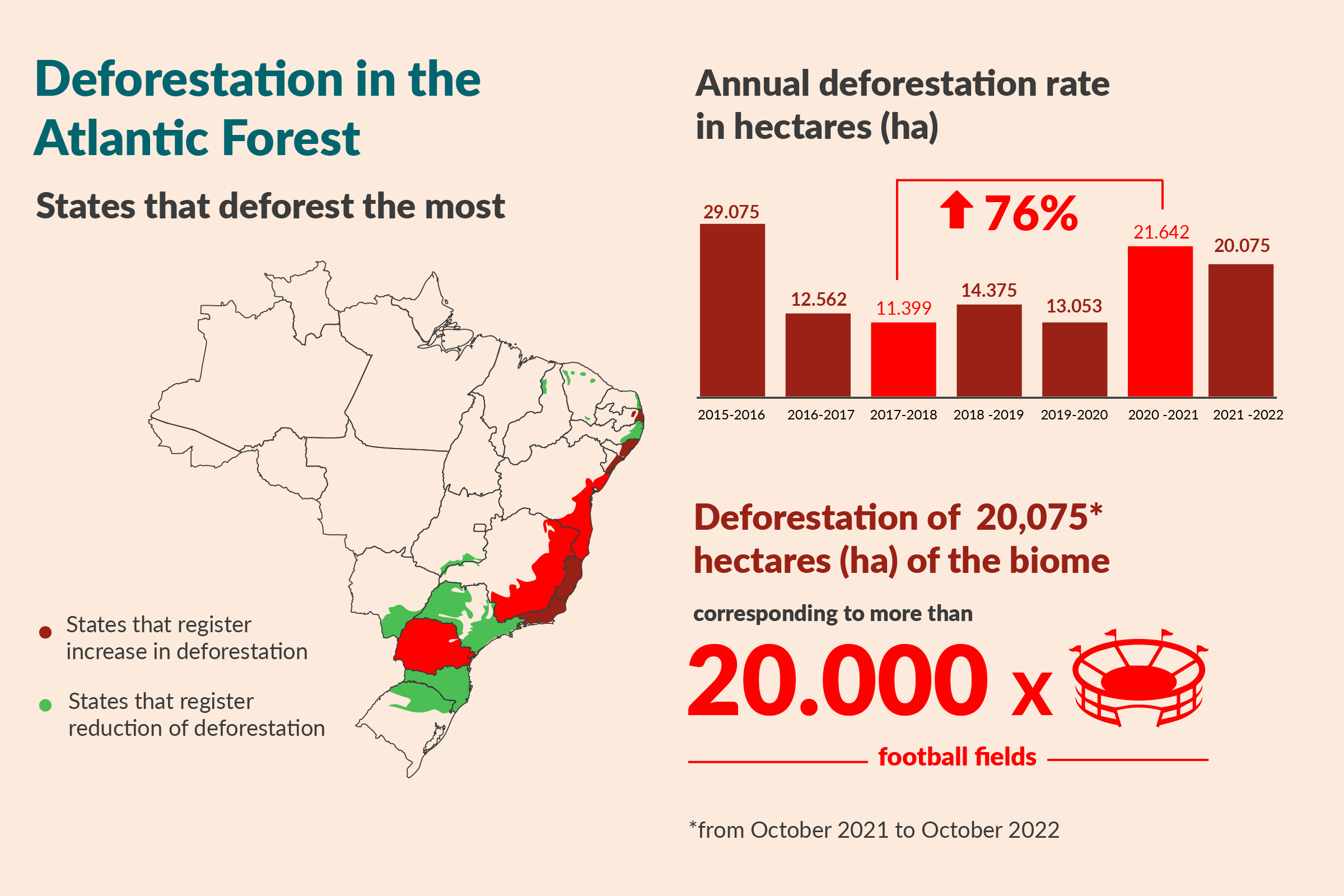Apoie nossas
causas
Activities and Balance of the SOS Mata Atlântica Foundation in 2023
In addition to monitoring the biome's status nationally through tracking forest remnants and new deforestation, SOS Mata Atlântica's knowledge sector seeks to diversify and enhance available information about the biome. Our studies are widely disseminated through the press and social media and presented at international conferences, scientific congresses, and political forums.
Highlights in 2023:
The Atlantic Forest continues to lose valuable forest areas. According to the Forest Remnants Atlas, produced in partnership with the National Institute for Space Research (INPE), an area equivalent to over 20,000 football fields was deforested between October 2021 and 2022.
The good news is that this represents a 7% reduction compared to the previous period.
The downward trend was confirmed by the Atlantic Forest Deforestation Alerts System (SAD Mata Atlântica), developed in partnership with MapBiomas and Arcplan, which uses more precise lenses and can detect changes in areas ten times smaller than those identified by the Atlas.

The Atlas of the Atlantic Forest has been producing data since 1989, allowing for important long-term comparisons to understand the biome's history. Now, after completing its first year of analysis, the SAD system can start making comparisons. Its aim is to provide more frequent bulletins to expedite public authorities' responses to deforestation.
According to Luís Fernando Guedes Pinto, Executive Director of the Foundation, the Atlantic Forest Atlas and the first year of comprehensive analysis with the Atlantic Forest Deforestation Alerts System complement each other and are among the key tools to support combating deforestation in the biome.

Only 6.9% of the rivers monitored by 2,700 volunteers in the Observing Rivers program have good water quality. The 2023 diagnosis was similar to the previous year's, highlighting how far we are from a society with clean water for all.
Based on monthly collections between January and December 2022, 990 analyses were conducted at 160 points across 120 rivers and water bodies in 74 municipalities across 16 states in the Atlantic Forest.
In most cases (75%), water quality was rated as regular. More than 16% of the points had poor quality, and nearly 2% were rated as extremely poor. Among all 160 collection points in 120 rivers in the Atlantic Forest, no parameters of optimal quality were found.

The river that inspired the Observing Rivers program experienced increases in two conflicting indicators: the pollution patch expanded by about 30%, stretching over 160 kilometers, while the section with good water quality also grew, from 60 to 119 kilometers in 2022.
Most of the monitored stretch remains in regular condition, indicating overall stability in São Paulo's largest river.

The protected areas team conducted an extensive survey and made a surprising discovery: there are over 1,500 municipal conservation units in the Atlantic Forest, four times more than previously recorded in the National Registry of Conservation Units.
Combined, these units cover an area of 5.2 million hectares, indicating the importance of considering this category in formulating public policies for biome conservation.
Download the report or explore the data.
A recent study quantified, for the first time, the impact of soybean production on deforestation in the Atlantic Forest. Data from the Trase initiative, which promotes transparency and traceability in supply chains of major agricultural commodities linked to deforestation, revealed in its latest report (released in partnership with SOS Mata Atlântica Foundation) that 22,338 hectares of soybeans were planted in areas deforested between 2015 and 2019.
The study also highlighted that nearly half of this soybean production (46%) was exported to China, while 44% was consumed domestically in Brazil. Many of the traders involved have committed to zero-deforestation policies in their supply chains.
Read the article published in Valor Econômico for more details.
2023 Annual Report
Coordination
Marcelo Bolzan/Estúdio Verbo
Editor
Marina Vieira
Contributors
Afra Balazina; Aislan Silva; Carlos Abras; Diego Igawa Martinez; Gustavo Veronesi; Kelly De Marchi; Luís Fernando Guedes Pinto; Marcia Hirota; Maria Luísa Ribeiro; Olavo Garrido; and Rafael Bitante Fernandes
Image Research
Andrea Herrera and Marina Vieira
Graphic Design
Karine Costa
Editing
Ana Cíntia Guazzelli
Translation
Janaína Ribeiro
Image Credits
Ana Paula Guido; César R Santos; Fernando Castro; Fernando Donasci; Gustavo Veranesi; Isabela Lanute; JF Dorio; Léo Barrilari; Loan Barbosa; Matheus Mussolin; Sérgio Barzaghi; Rafael Bitante Fernandes; and SOS Mata Atlântica Archive